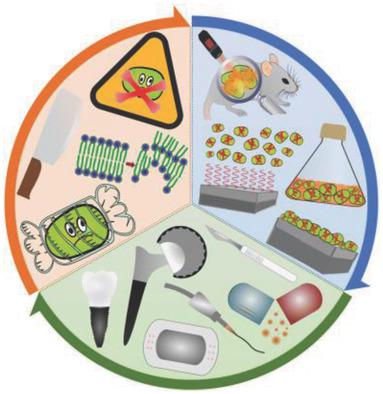当前位置:
X-MOL 学术
›
Adv. Healthcare Mater.
›
论文详情
Our official English website, www.x-mol.net, welcomes your
feedback! (Note: you will need to create a separate account there.)
Graphene Materials in Antimicrobial Nanomedicine: Current Status and Future Perspectives
Advanced Healthcare Materials ( IF 10.0 ) Pub Date : 2018-03-05 , DOI: 10.1002/adhm.201701406 Hüseyin Enis Karahan 1, 2, 3 , Christian Wiraja 2 , Chenjie Xu 2, 4 , Jun Wei 3 , Yilei Wang 5 , Liang Wang 5 , Fei Liu 6 , Yuan Chen 1
Advanced Healthcare Materials ( IF 10.0 ) Pub Date : 2018-03-05 , DOI: 10.1002/adhm.201701406 Hüseyin Enis Karahan 1, 2, 3 , Christian Wiraja 2 , Chenjie Xu 2, 4 , Jun Wei 3 , Yilei Wang 5 , Liang Wang 5 , Fei Liu 6 , Yuan Chen 1
Affiliation

|
Graphene materials (GMs), such as graphene, graphene oxide (GO), reduced GO (rGO), and graphene quantum dots (GQDs), are rapidly emerging as a new class of broad‐spectrum antimicrobial agents. This report describes their state‐of‐the‐art and potential future covering both fundamental aspects and biomedical applications. First, the current understanding of the antimicrobial mechanisms of GMs is illustrated, and the complex picture of underlying structure–property–activity relationships is sketched. Next, the different modes of utilization of antimicrobial GMs are explained, which include their use as colloidal dispersions, surface coatings, and photothermal/photodynamic therapy agents. Due to their practical relevance, the examples where GMs function as synergistic agents or release platforms for metal ions and/or antibiotic drugs are also discussed. Later, the applicability of GMs in the design of wound dressings, infection‐protective coatings, and antibiotic‐like formulations (“nanoantibiotics”) is assessed. Notably, to support our assessments, the existing clinical applications of conventional carbon materials are also evaluated. Finally, the key hurdles of the field are highlighted, and several possible directions for future investigations are proposed. We hope that the roadmap provided here will encourage researchers to tackle remaining challenges toward clinical translation of promising research findings and help realize the potential of GMs in antimicrobial nanomedicine.
中文翻译:

抗菌纳米医学中的石墨烯材料:现状和未来展望
石墨烯材料(GMs),例如石墨烯,氧化石墨烯(GO),还原GO(rGO)和石墨烯量子点(GQDs),正迅速成为一类新型的广谱抗菌剂。本报告介绍了它们的最新技术和潜在的未来,涵盖了基本方面和生物医学应用。首先,说明了对转基因抗菌机制的当前理解,并勾勒了潜在的结构,性质,活性关系的复杂图景。接下来,解释了抗微生物GM的不同利用方式,包括它们作为胶体分散体,表面涂层和光热/光动力治疗剂的用途。由于它们的实用性,还讨论了GMs作为金属离子和/或抗生素药物的协同剂或释放平台的例子。后来,评估了转基因在伤口敷料,防感染涂层和类抗生素制剂(“纳米抗生素”)设计中的适用性。值得注意的是,为了支持我们的评估,还对常规碳材料的现有临床应用进行了评估。最后,重点介绍了该领域的主要障碍,并提出了一些可能的未来研究方向。我们希望,此处提供的路线图将鼓励研究人员应对有希望的研究结果进行临床翻译时仍面临的挑战,并帮助实现转基因技术在抗菌纳米药物中的潜力。评估了防感染涂层和类抗生素制剂(“纳米抗生素”)。值得注意的是,为了支持我们的评估,还对常规碳材料的现有临床应用进行了评估。最后,重点介绍了该领域的主要障碍,并提出了一些可能的未来研究方向。我们希望,此处提供的路线图将鼓励研究人员应对有希望的研究结果进行临床翻译时仍面临的挑战,并帮助实现转基因技术在抗菌纳米药物中的潜力。评估了防感染涂层和类抗生素制剂(“纳米抗生素”)。值得注意的是,为了支持我们的评估,还对常规碳材料的现有临床应用进行了评估。最后,重点介绍了该领域的主要障碍,并提出了一些可能的未来研究方向。我们希望,此处提供的路线图将鼓励研究人员应对有希望的研究结果进行临床翻译时仍面临的挑战,并帮助实现转基因技术在抗菌纳米药物中的潜力。并提出了一些可能的未来研究方向。我们希望,此处提供的路线图将鼓励研究人员应对有希望的研究结果进行临床翻译时仍面临的挑战,并帮助实现转基因技术在抗菌纳米药物中的潜力。并提出了一些可能的未来研究方向。我们希望,此处提供的路线图将鼓励研究人员应对有希望的研究结果进行临床翻译时仍面临的挑战,并帮助实现转基因技术在抗菌纳米药物中的潜力。
更新日期:2018-03-05
中文翻译:

抗菌纳米医学中的石墨烯材料:现状和未来展望
石墨烯材料(GMs),例如石墨烯,氧化石墨烯(GO),还原GO(rGO)和石墨烯量子点(GQDs),正迅速成为一类新型的广谱抗菌剂。本报告介绍了它们的最新技术和潜在的未来,涵盖了基本方面和生物医学应用。首先,说明了对转基因抗菌机制的当前理解,并勾勒了潜在的结构,性质,活性关系的复杂图景。接下来,解释了抗微生物GM的不同利用方式,包括它们作为胶体分散体,表面涂层和光热/光动力治疗剂的用途。由于它们的实用性,还讨论了GMs作为金属离子和/或抗生素药物的协同剂或释放平台的例子。后来,评估了转基因在伤口敷料,防感染涂层和类抗生素制剂(“纳米抗生素”)设计中的适用性。值得注意的是,为了支持我们的评估,还对常规碳材料的现有临床应用进行了评估。最后,重点介绍了该领域的主要障碍,并提出了一些可能的未来研究方向。我们希望,此处提供的路线图将鼓励研究人员应对有希望的研究结果进行临床翻译时仍面临的挑战,并帮助实现转基因技术在抗菌纳米药物中的潜力。评估了防感染涂层和类抗生素制剂(“纳米抗生素”)。值得注意的是,为了支持我们的评估,还对常规碳材料的现有临床应用进行了评估。最后,重点介绍了该领域的主要障碍,并提出了一些可能的未来研究方向。我们希望,此处提供的路线图将鼓励研究人员应对有希望的研究结果进行临床翻译时仍面临的挑战,并帮助实现转基因技术在抗菌纳米药物中的潜力。评估了防感染涂层和类抗生素制剂(“纳米抗生素”)。值得注意的是,为了支持我们的评估,还对常规碳材料的现有临床应用进行了评估。最后,重点介绍了该领域的主要障碍,并提出了一些可能的未来研究方向。我们希望,此处提供的路线图将鼓励研究人员应对有希望的研究结果进行临床翻译时仍面临的挑战,并帮助实现转基因技术在抗菌纳米药物中的潜力。并提出了一些可能的未来研究方向。我们希望,此处提供的路线图将鼓励研究人员应对有希望的研究结果进行临床翻译时仍面临的挑战,并帮助实现转基因技术在抗菌纳米药物中的潜力。并提出了一些可能的未来研究方向。我们希望,此处提供的路线图将鼓励研究人员应对有希望的研究结果进行临床翻译时仍面临的挑战,并帮助实现转基因技术在抗菌纳米药物中的潜力。











































 京公网安备 11010802027423号
京公网安备 11010802027423号